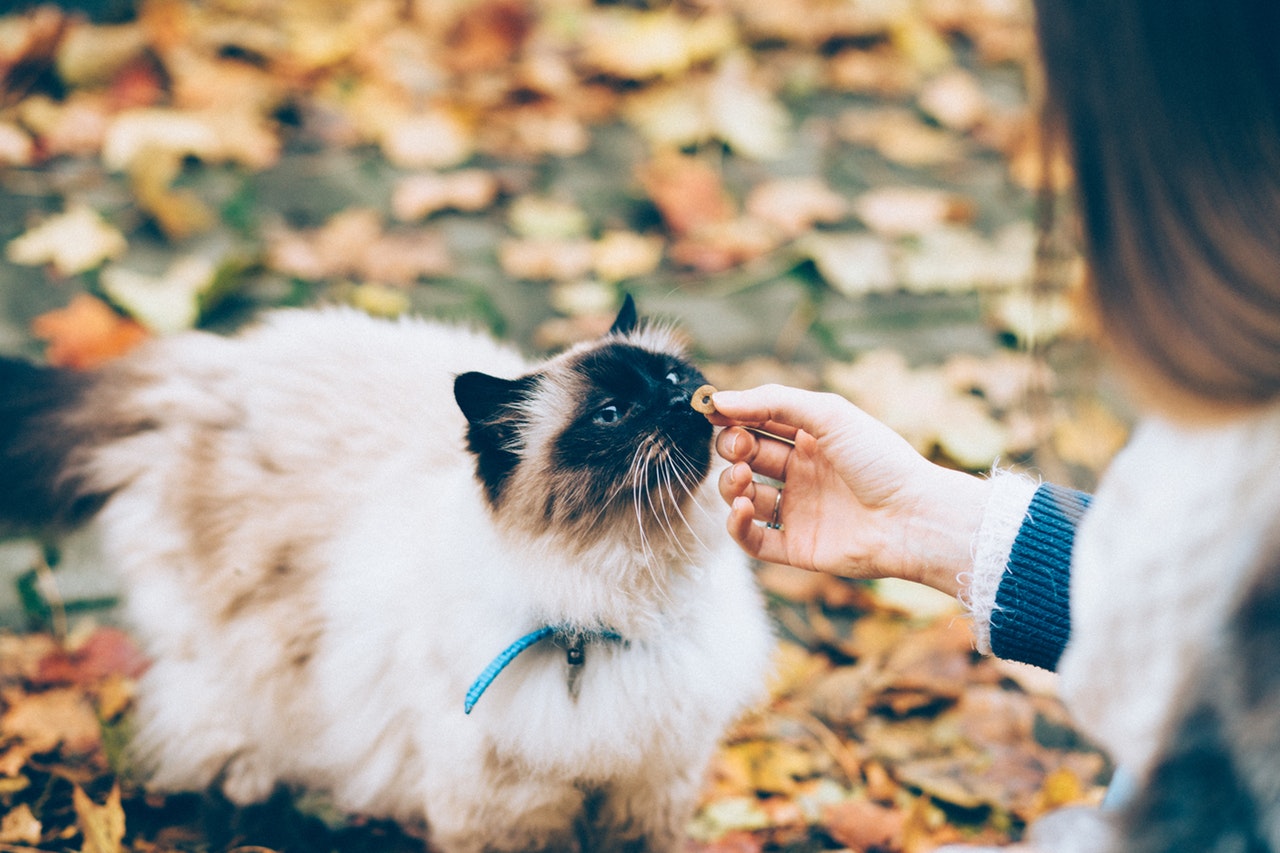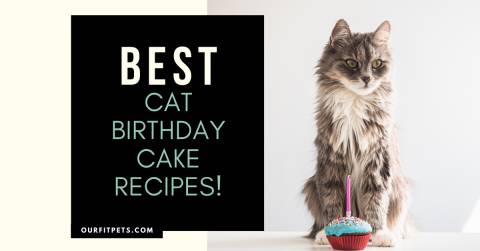How much should I feed my cat? This is a common question asked by cat lovers all around the world. This can be an especially difficult question for new cat owners, too. We love our feline fur babies and want to keep them healthy and at a healthy weight. In short, we want to do what’s best for them.
Connect with a verified veterinarian in minutes. Licensed vets are available 24/7 to answer your questions. No need to worry about your furry family member.
The answer to this question largely depends on several factors, including your cat’s age, weight, activity level, and more. Don’t forget your cat’s metabolism should also be factored in, along with the type of food, number of calories and its nutritional values. And remember that young kittens and pregnant cats require more calories than adult or older cats.
Daily Nutrition and Calories Your Cat Needs
All cats, young & old, need a certain number of calories and specific nutrition to stay healthy their entire lives. Let’s take a look at what your cat needs to stay healthy and fit:
a. Protein: cats are carnivores and require protein from animal sources such as meat, fish, poultry, etc. Cat’s don’t easily process plant-based proteins, while animal protein is easier for your fur baby to digest. These proteins provide your cat with the amino acids she needs to keep her system running smoothly. Important amino acids include arginine, taurine, etc.
b. Fats: are another important component to watch for in your kitty’s food. Fats can be animal-based or plant-based and provide your cat or kitten with the energy she needs throughout her busy day. Not only do fats provide energy, but they also include fatty acids that are necessary to carry fat-soluble vitamins throughout her body, while keeping her skin and coat healthy.
c. Vitamins: are essential substances that provide a wide range of health benefits. Your kitty’s food should contain:
- Vitamin A: 63 μg
- Vitamin D: 0.4 μg
- Vitamin E: 2.5 mg
- Vitamin K: 82 μg
- Vitamin B-1: 0.33 mg
- Vitamin B-6: 0.16 mg
- Riboflavin: 0.27 mg
- Niacin: 2.5 mg
- Pantothenic Acid: 0.4 mg
- Folic acid: 47 μg
- Vitamin B-12: 1.4 μg
d. Minerals: your fur baby also requires the right mix and amount of minerals each day, including calcium (0.18 g), phosphorous (0.16 g), sodium (42 mg), potassium (0.33 g), chlorine (60 mg), magnesium (25 mg), iron (5 mg), copper (0.3 mg), zinc (4.6 mg), manganese (0.3 mg), selenium (19 μg) and iodine (88 μg).
These are the average daily nutritional requirements for adult cats. These requirements will be slightly different for kittens or pregnant, nursing mother cats.
How Do Cats Eat in the Wild?
In the wild, cats are carnivores and eat their food raw. They hunt and kill small animals including mice, rabbits, squirrels, etc. They’ll also eat lizards, birds, bugs and small fish. When cats eat their prey, they’ll generally eat most parts of the animal, including bones, hair, meat, entrails, etc. This doesn’t very appetizing to us, but this is what cats eat when in nature.
It’s important to note that cats generally don’t eat plants in the wild. Instead, the animals they eat plants, and the nutrients from these plants are passed on to the cat living in the wild. Remember, cats generally eat the entire animal, including whatever that animal ate (such as plants).

Review symptoms, medications & behavior to keep your pets healthy with a Vet Online in just minutes.
Ask a Vet Live NowHow Do Domestic Cats Tend to Eat?
Most domestic cats will occasionally catch a rodent, such as a mouse, and eat it. However, they get most of their daily nutritional requirements from commercial cat food, homecooked cat foods or even a raw diet provided by their owner.
Some cats tend to nibble all through the day, while others may enjoy one or two meals a day. It just depends on your cat and your daily schedule. Some people do leave dry food out all day for their cat to eat, which can be either good or bad, depending on your cat’s overall health and weight.
What Type of Cat Food is Best?
The next consideration is what type of cat food is best for your fur baby. This depends, again, on your cat’s age, overall health and weight. This question typically involves deciding which type of food—dry or wet—to your kitty. Which is better?
Let’s take a look at the pros of dry and wet cat food:
Dry food is:
- Usually cheaper
- Doesn’t spoil as quickly
Wet food is:
- Higher in protein
- Contains extra moisture your cat needs (to prevent urinary and kidney problems)
- Most cats will eat wet food (even finicky eaters)
So, which is best? It mainly depends on what your cat likes to eat, along with the nutritional value provided by the cat food. If you have a new cat or a finicky eater, it may be necessary to experiment to find which type of food she prefers.
Some cat owners even choose to feed their cats a mixture of both wet and dry foods, as this way the cat can enjoy the best of both worlds. Still, it comes down to what your kitty will eat.
How Much to Feed My Cat?
Now that we’ve taken a good look at your cat’s daily nutritional requirements, it’s time to consider how much food to feed your cat each day.
According to PetMD’s feeding guide, here’s what to feed your cat:
If your cat weighs: Feed This Amount Per Day
5 lbs (2.3 kg) ¼ cup (30 g) – 1/3 cup (40 g)
10 lbs (4.5 kg) 3/8 cup (45 g) – ½ cup (65 g)
15 lbs (6.8 kg) ½ cup (65 g) – ¾ cup (95 g)
How to Feed My Cat Each Day?
You’ve chosen your kitty’s food, know about how much to give her, but now you’re probably wondering about the best way to feed her each day! That’s a good question, with multiple answers. If you’re feeding your fur baby dry cat food, then measure the amount for each days’ feeding. Now, consider how often you’ll feed her—will she have all-day access to her food, when she wants it? Or will you feed her at specific times each day—maybe twice a day? You can choose to leave the entire day’s amount of food out in a bowl for your kitty to eat as she wants. At the end of the day, throw away any uneaten food, to avoid giving her stale food, or food that’s gotten wet. Dry cat food, that’s become wet, can quickly develop mold, which could make your cat sick.
If you’ve chosen to divide your kitty’s food up during the day, then at each serving, only give her a portion of that day’s amount of food. For instance, if you choose to feed her once in the morning and once in the evening, then divide the amount of that day’s food in half, and give her a ½ serving for each meal. Feeding her three times a day you can divide the day’s food amount equally between those three meals, etc. One thing to keep in mind—wet food will spoil quickly over the course of the day. This is especially true during hot weather. On the other hand, dry food will be OK until the end of the day—safe for your cat to eat at any point in her busy day.
Feeding Overweight Cats
If you’re feeding your fur baby according to the measurements we shared earlier, and she’s gaining weight, then it will be necessary to cut down on the amount of food you give her each day. You don’t want your cat to become a furry ball! Being overweight or obese can lead to many health issues for your cat. So, the goal is to maintain a healthy weight—so she’s not too skinny or too fat.
On the other hand, if she becomes too skinny, then increase her food slightly, until she’s the right weight.
We hope this guide helps you to feed your cat the food that’s best for her, while maintaining her optimal weight with the right amount of food for her age, weight, and activity level. If you have further questions, please consult your veterinarian, as they know your cat and her health. Your vet will be the best guide when it comes to your precious fur baby’s health.
Connect with a verified veterinarian in minutes. Licensed vets are available 24/7 to answer your questions. No need to worry about your furry family member.

Tom
Tom has always loved to write since he was little - he wanted to be either a writer or a veterinary doctor, but he ended up being a professional writer while most of his works are based on animals. He was born in San Francisco but later moved to Texas to continue his job as a writer. He graduated from the University of San Francisco where he studied biotechnology. He is happily married and a soon to be father!
Review symptoms, medications & behavior to keep your pets healthy with a Vet Online in just minutes.
Ask a Vet Live Now



